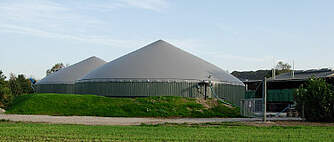Biogas Plant BLUEMEL
| Location | Germany |
| Construction Period | 1994/1995 |
| Input | Biowaste, separately collected in households |
| Yield | 13.000 Mg/a |
| Fermenter | Two concrete tanks, 800 m3 each |
| Gas utilization | Two dual fuel go-generators, 160 kWel each |
| Specials | Gas holders on top of both fermenters |
| Responsibility | Basic evaluation, pre-, draft-, approval and execution planning, site management/project controlling, start-up (for TBW GmbH) |
Description In this large-scale biogas plant there is no digestion of manure but rather digestion of so-called biowaste. This biowaste is collected in special bins in each individual household. It consists of garden and kitchen wastes. Because of faulty collection there are some plastics, batteries, stones, etc. included. Consequently, there is need for pretreatment before digestion. This includes removal of non-digestable parts (foreign objects), sieving, grinding and so on. In fact this biogas plant is not an agricultural one at all but an industrial one. Standards and engineering requirements are at a much higher level. The BLUEMEL biogas plant is a two-stage plant including complete pretreatment, two hydrolysis tanks, two digesters, two diesel-gas-engines, a dewatering aggregate and posttreatment (composting) of digested dewatered substrate. Most of its sections operate automatically. Close to the biogas plant are a composting yard and a wood treatment factory. The fresh biowaste is delivered by standard refuse collection vehicles. These vehicles drive to each individual household, take the contents of the biowaste bins and transport it to the biogas plant. There it is unloaded in the big pretreatment hall. Following this a frontloader transfers the biowaste directly to the process: sieving, grinding, sorting out of foreign objects. The clean and ground biowaste is transported with a conveyor belt into a small tank. There all the biowaste is slurried with recycled water. Afterwards this slurry is pumpable. In contrast to manure digestion this substrate (especially kitchen waste) cannot be treated with simple process technology. Therefore, in this situation a two-stage process was proposed. The food chain mentioned at the beginning of this report is now devided into two parts. The advantage is that each kind of involved microorganisms can be treated the most optimal way. The first stage of the biological process is called hydrolysis. In the hydrolysis tank there are comparatively low pH-values and the produced gas is merely carbon dioxide (CO2). This gas cannot be used energetically. For this reason there is a biofilter which the gas has to pass through, the gas is cleaned and can be released to the environment. The microorganisms within the two hydrolysis tanks at BLUEMEL biogas plant are responsible for best pretreatment of input substrate before it is transferred to the digesters. There are two digesters with a volume of 800 m3 each. After a hydraulic retention time of about 15 days in the first one, the mesophilic tank, the substrate is pumped to the second one, the thermophilic tank, which has a similar hydraulic retention time. Both digesters are equipped with three agitators and are heated by internal hot water tubes. Directly above each digester is a gas storage membrane with a volume of about 150 m3. After digestion the substrate is dewatered. The liquid phase is recycled and used again for slurrying of fresh substrate. The dewatered substrate is transferred to the composting yard. Since all the readily degradable parts have been digested during the anaerobic treatment, the residual matter is nearly odourless. Therefore Mr. Bluemel was permitted to construct his composting yard without a hall. The biogas produced is burnt in two diesel gas engines. The two aggregates have a combined electrical power output of 350 kW. The entire biogas plant works self-sufficiently. Different from simple composting plant, Mr. Bluemel not only has no costs for electricity but he can also even earn money by selling surplus electricity. The whole biogas plant is supervised and controlled by an overall process control system. Each measurement - for example at the digesters, the gas holders, the engine - and the complete pretreatment is recorded centrally. All important measured values are displayed on the central process control unit (PCU). All the plant is driven from this headquarter. But, although many units of the biogas plant are controlled automatically, operation without a works manager and several workers is inconceivable. The BLUEMEL biogas plant was erected in 1994 and 1995. After a fire in the old pretreatment hall, a new pretreatment hall was constructed in a slightly different style. Today the biogas plant is in operation again. This is a rough description for a large-scale and sophisticated biogas plant. For engineering and construction of this type of plant a lot of knowhow is necessary. Without consultants who have many years of experience in biogas plants plus additional experience with substrate-specific attributes of the input such a plant cannot be realised.


